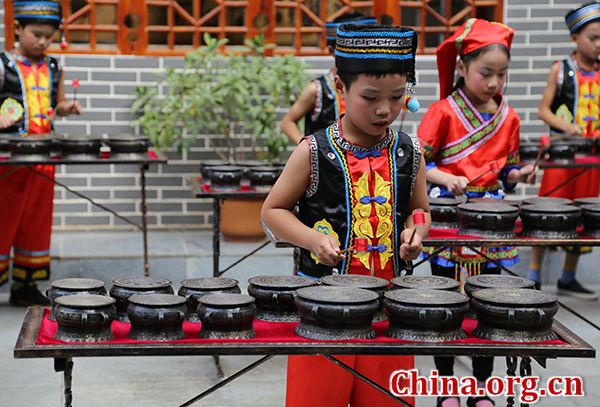Passing down the drum
china.org.cn / chinagate.cn by Zhang Lulu, December 5, 2016 Adjust font size:
10-year-old Wei Duanduan, clad in traditional Zhuang ethnic attire, was both bashful and overjoyed during his performance of the bronze drum in front of a group of visitors. The melody he and his schoolmates played was entitled "Beautiful Donglan." Donglan is a county in south China's Guangxi Zhuang Autonomous Region, which is called "the land of bronze drums."
 |
|
Wei Duanduan plays the bronze drum. [Photo by Zhang Lulu / China.org.cn] |
Tonggu, or bronze drum, is a percussion instrument dating back to more than 2,000 years. The ancient drum is usually found in south China, especially Guangxi, as well as southeastern Asian countries such as Vietnam and Myanmar. The drum, which originally evolved from cooking utensils such as cauldrons and bronze kettles, has been and is still used by some Zhuang people during major festivals and rituals.
There are 2,400 ancient bronze drums in the world, one fourth of which are in Donglan County, according to the local government.
World's first bronze drum collection
Donglan Private Bronze Drum Collection is the world's first bronze drum collection, according to Chen Zhenyang, the owner of the collection museum.
Chen, 32, is the son of Chen Yaoling, an avid collector of bronze drums. The younger Chen said his father began collecting the drums in the 1970s. The bronze drum, like many other traditional arts, was deemed as a "feudal superstition" during the tumultuous Cultural Revolution. "My father thought it would be such a pity to throw the drums away or sell them for bronze and iron, so he began to seek for them in the remote Yao ethnic counties," Chen said.
The old Chen continued his collection till the 1990s when he found his home crammed with more than 150 drums. Those drums, which were piled up one by one then, were a marvel to many visitors, according to the younger Chen.
In the 2000s, the bronze drum was listed as China's intangible cultural heritage, and the government began to recognize and endorse the ancient art. With the support of the local government, the Chen family began to build a collection museum for the drums, which was officially opened to the public in 2011.
Chen Zhenyang, who left the impoverished county for university and work, came back to Donglan County in recent years to look after the collections. Besides two guides who work at the museum regularly, Chen himself sometimes also works as a guide, telling visitors the stories of each of the drums.
The 150 drums come in a wide variety of shapes, sizes and functions, Chen explained to visitors. Gourd-shaped drums were used in ancient times to offer sacrifices and make wishes; drums that have mini statues of warhorses and frogs symbolize battle and fertility; a girl carrying a cauldron-shaped drum documents the ritual of maidens praying for rain.